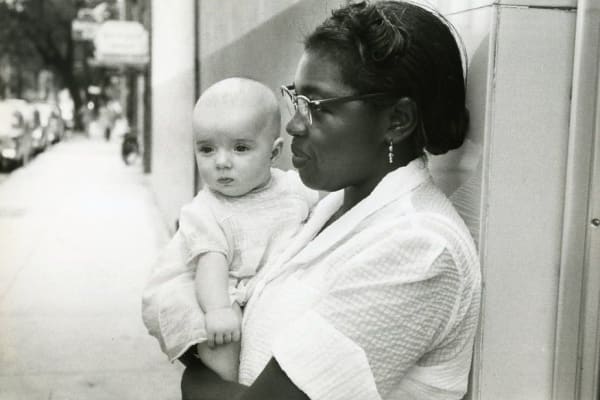Robert Frank: American solitude
Robert Frank has rarely had his work exhibited in a gallery on the European continent, much less in France, so it is with immense pleasure that Les Douches La Galerie brings together a group of fifteen photos that belonged to Sid Kaplan, the man who made the prints, and whom we also have the honour to present. This exhibition event was developed in partnership with the New York gallery Deborah Bell Photographs.
Opening on January 26, 2023 from 6 to 9 pm
-

Double exposition Leon Levinstein et Robert Frank aux Douches
Carine Dolek, Réponses Photo, 7 March 2023 -

Sélection galeries : Robert Frank et Leon Levinstein aux Douches
Claire Guillot, Le Monde, 4 March 2023 -

Robert Frank, American Solitude
Frédérique Chapuis, Télérama Sortir, 7 February 2023 -

« Robert Frank, American Solitude » : une plongée en images dans les Etats-Unis des années 1950
Claude Soula, L'Obs, 3 February 2023
Robert Frank and Sid Kaplan represent first and foremost a long history of friendship and mutual respect. Their story began in 1968 when Kaplan decided to set up his own photo lab. The two had already met at Compo, where most New York photographers dropped off their negatives and handed over their prints to the men in the shadows. Frank had already tried his hand at the exercise but had not kept up for long. The story goes that it was the photographer Ralph Gibson who introduced him to Sid Kaplan in his neighbourhood on the Lower East Side. And even though Kaplan was never the sole printer Frank used, he played a key role in re-evaluating his work, especially beginning in the 1980s, in American museums. Spurred on by the notorious demandingness of the Swiss emigré – Frank had come to New York in 1947 – Kaplan had to raise his technical level in order to master Frank’s black and white in continual imbalance, baffled between grainy film and on-the-fly framing. Since he himself had taken up a camera specifically to document the life of his neighbourhood, Kaplan knew all too well just how much the publication of The Americans in 1958, in France, then in 1959 in the United States, had changed the game. There was now a before and an after in the history of photography. So it is not a coincidence that in the group of prints presented for the first time at Les Douches La Galerie, there are nine photographs from the series that was immortalised between 1954 and 1956 thanks to the fellowship that Frank received from the Guggenheim Foundation. Six of them (1) appeared in The Americans, which was published initially by Robert Delpire, and a year later, by Grove Press in New York. The three others were not kept. Among the six, there are two that have become iconic: Charleston, South Carolina, 1955 and Los Angeles 1955-1956. In the first, a Black woman holds a white baby in her arms – a symbolic image of a time when racial segregation was rife, especially in the American South. In the second, a man walks alone down the road, as if pushed along by an arrow above him that he cannot see – a perfect evocation of the urban loneliness inflicted upon a good number of Frank’s contemporaries in big American cities. ‘With that little camera that he raises and snaps with one hand, he sucked a sad poem right out of America onto film, taking rank among the tragic poets of the world’, as Jack Kerouac says in his preface.
A third photo emerges from the subset of The Americans presented here: U.S. 91, leaving Blackfoot, Idaho, 1956. Frank set off by car with two Latino Americans, one of whom was driving. He invites us on his own travels, a long tramping journey with motley companions. Going on the road also meant seeing up close all those anonymous carefree faces, and all those lives that could quickly veer off course.
Robert Frank’s life, it should be said, was not smooth sailing either. From the 1970s on, he suffered from depression and hard times. His films and photographic experiments took on another, completely different documentary tone, which was largely autobiographical. After his divorce from Mary Lockspeiser in 1969, he spent more and more time in Mabou in Nova Scotia, in an old fishing house, accompanied now by the artist June Leaf whom he went on to marry. The deaths of his daughter Andrea, at twenty, in a plane crash, and his son Pablo, who was diagnosed with schizophrenia and who committed suicide twenty years later at age forty-three, thrust him into a sadness from which he was never able to emerge. Both appear sometimes like ghosts in films (Conversations in Vermont, True Story, and so on), but also in photomontages, like the one presented here, St. Patrick’s New York City / Brattleboro, Vermont, 1978-79, where in the upper photo we see Pablo with his long black hair. The same blackness also permeates his polaroids, scratched by words or ridges that visually enhance the wrongs, and other snapshots that illustrate his very last works, celebrating his life, his friends and the death that finally overtook him in September 2019. This exhibition is thus a sort of homage, in 2023, as we celebrate the sixty-fifth anniversary of the first publication of his book, The Americans.
Philippe Séclier
Director of the film-documentary An American Journey - In Robert Frank’s Footsteps
(Silex Films, 2009)
(1) Newburgh, New York, 1955
Charleston, South Carolina, 1955
Rodeo – Detroit, 1955
U.S. 91, leaving Blackfoot, Idaho, 1956
Los Angeles, 1955-56
Belle Isle, Detroit, 1955








